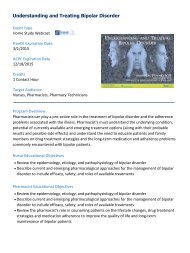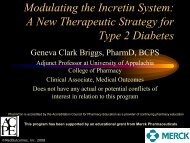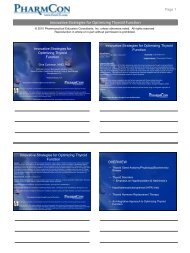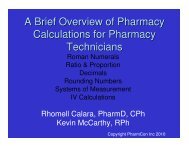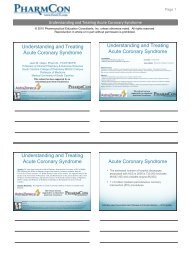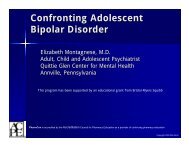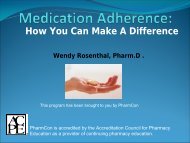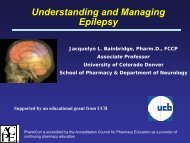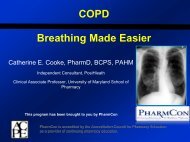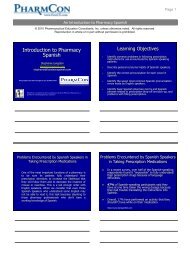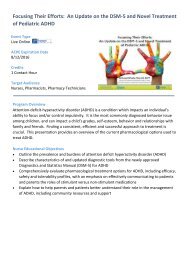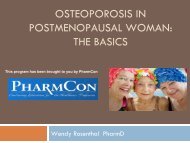The Pathophysiology and Pharmaceutical Treatment of Gout
The Pathophysiology and Pharmaceutical Treatment of Gout
The Pathophysiology and Pharmaceutical Treatment of Gout
Create successful ePaper yourself
Turn your PDF publications into a flip-book with our unique Google optimized e-Paper software.
It should be noted that most <strong>of</strong> the research conducted on the prevalence <strong>of</strong> gout was based upon clinicalassessments, self-reports <strong>and</strong> medical record or database reviews. However, these are not as sensitive oras specific as microscopic identification <strong>of</strong> monosodium urate crystals within inflamed joints which isconsidered the “gold st<strong>and</strong>ard” for gout diagnosis. 9 Identification <strong>of</strong> intracellular urate crystals in thesynovial fluid or tophus substantiates the diagnosis <strong>of</strong> gout, but it does not exclude other causes <strong>of</strong> jointinflammation such as acute pseudogout, active rheumatoid arthritis, or in rare cases, septic arthritis. 10Crystal-induced arthritis can mimic septic arthritis in terms <strong>of</strong> severe pain, fever, high synovial whiteblood cell count <strong>and</strong> other constitutional symptoms. Septic arthritis should be suspected in patients withworsening synovitis despite treatment <strong>of</strong> suspected acute gout. Synovial fluid gram stain <strong>and</strong> culture arecritical in aiding with the diagnosis in such patients.Several studies have also examined the incidence <strong>of</strong> gouty arthritis. For example, the Framingham HeartStudy, which followed over 5,000 people for almost three decades, discovered that the incidence <strong>of</strong> goutper 1,000 people was 1.4 women <strong>and</strong> 4.0 men, indicating that gout is almost three-times more common inmen. 11 In other studies, gout incidence was also higher in men than in women <strong>and</strong> the rates increased withadvancing age.Risk FactorsSeveral risk factors have been identified for the development <strong>of</strong> gout including hyperuricemia.Hyperuricemia, or high levels <strong>of</strong> uric acid in the blood serum, is considered the most essential factor inthe pathogenesis <strong>of</strong> gout. In a Taiwanese study, the prevalence <strong>of</strong> gout was over four times higher in menwho had been previously diagnosed with asymptomatic hyperuricemia. 12 Uric acid precipitates out <strong>of</strong>solution <strong>and</strong> forms urate crystals when it reaches a saturation threshold that is partially dependent on pHlevels <strong>and</strong> other biochemical factors.Genetic factors are also fairly evident in gout, but gene expression is quite variable, which accounts forthe differences in an individual’s genotype <strong>and</strong> phenotype. Because the kidneys excrete the majority <strong>of</strong>uric acid from the body, families with genetic conditions limiting kidney clearance <strong>of</strong>ten have a higherincidence <strong>of</strong> gout. 13 For example, a certain gene codes for human “urate transporter-1,” which isimportant for controlling reabsorption <strong>of</strong> uric acid from the proximal tubules <strong>of</strong> the kidneys. As such,urate transporter-1 is targeted by many drugs that influence serum uric acid levels in efforts to reduce theprevalence <strong>of</strong> gout.A direct link between gout <strong>and</strong> diet has been recognized for centuries, which is why gout has been labeledthe “rich man’s arthritis” for many years. In general, diets high in purines, which are found in abundancein organ meats, cured meats, seafood, some vegetables, aged cheese, <strong>and</strong> red wine <strong>and</strong> beer, significantlyincrease the risk <strong>of</strong> gout because the purines are metabolized into uric acid within the body. In scientificstudies, dietary consumption <strong>of</strong> meats <strong>and</strong> seafood was found to be associated with the highest risks <strong>of</strong>gout, whereas consumption <strong>of</strong> certain dairy products such as milk appeared to <strong>of</strong>fer protection. 14 Otheridentified risk factors include consumption <strong>of</strong> sugar-sweetened s<strong>of</strong>t drinks, c<strong>and</strong>y, <strong>and</strong> sugarycarbohydrates such as donuts, whereas other protective factors include consumption <strong>of</strong> caffeinated c<strong>of</strong>fee<strong>and</strong> high doses (greater than 1,500 mg daily) <strong>of</strong> vitamin C. 15 Excessive alcohol consumption (seven ormore drinks within 48 hours) is a well-established trigger <strong>of</strong> acute gout attacks. 16Specific purine-rich foods to avoid or minimize in order to reduce the risk <strong>of</strong> acute gout attacks includebeef, liver, kidney, game meats, goose, pork, sweetbreads, anchovies, herring, sardines, mackerel,mussels, crab, shrimp, lobster, caviar, mussels, mushrooms, yeast, asparagus, spinach, cauliflower, peas,beans, lentils, most nuts <strong>and</strong> seeds, wheat, rye <strong>and</strong> essentially any form <strong>of</strong> alcohol. 17Dufton – <strong>Pathophysiology</strong> <strong>and</strong> <strong>Treatment</strong> for <strong>Gout</strong> Page 2
consumption <strong>of</strong> antioxidant-rich foods or strong antioxidant supplements such as vitamins C <strong>and</strong> E inefforts to minimize joint tissue damage, eating sour cherries <strong>and</strong> cranberries or drinking their juices inattempts to dissolve the urate crystals, avoiding purine-rich foods, reducing alcohol consumption, <strong>and</strong>increasing purified water consumption to dilute the crystals <strong>and</strong> help flush them out <strong>of</strong> the body. Tocombat pain <strong>and</strong> inflammation, non-pharmacological compounds commonly used includemethylsulfonylmethane (MSM), Harpagophytum procumbens (Devil’s claw), Uncaria tomentosa (Cat'sclaw), Ananus comosus (bromelain) <strong>and</strong> Curcuma longa (turmeric). 21 Acupuncture <strong>and</strong> homeopathictinctures are also utilized for pain <strong>and</strong> inflammation control, although no scientific studies have examinedtheir effectiveness for acute gout attacks. Alternating hot <strong>and</strong> cold compresses is a simple inflammationcontrol method that is backed by some research in regards to acute gouty arthritis. 22In conclusion, gout is the most common form <strong>of</strong> inflammatory arthritis <strong>and</strong> its prevalence <strong>and</strong> incidencehave risen in recent decades. Numerous risk factors for the development <strong>of</strong> gout in both men <strong>and</strong> womenhave been established <strong>and</strong> include hyperuricemia, genetic factors, age, purine-rich diet, alcoholconsumption, sluggish metabolism, obesity, diuretic use, renal disease, hypertension <strong>and</strong> possiblyosteoarthritis. <strong>Gout</strong> can mimic other types <strong>of</strong> arthritis <strong>and</strong> joint injuries, so urate crystals from joint fluidmust be identified for accurate diagnosis. Alternative therapies have been used to combat gout forcenturies, although pharmaceutical treatment is the best researched <strong>and</strong> most utilized by modernmedicine. Untreated, gout can cause significant short-term <strong>and</strong> long-term disability.<strong>The</strong> <strong>Pharmaceutical</strong> <strong>Treatment</strong> <strong>of</strong> <strong>Gout</strong><strong>The</strong> majority <strong>of</strong> patients who experience gout are cared for by their family physicians. Although both thephysician <strong>and</strong> patient may easily recognize that they are dealing with an acute gout attack, errors inselecting the most appropriate medication <strong>and</strong> proper dose are common. <strong>The</strong> clinical stages <strong>of</strong> gout aredivided into the asymptomatic hyperuricemia stage, the intermittent acute flare-up stage <strong>and</strong> the chronictophi-forming stage. 23,24 <strong>Treatment</strong> <strong>of</strong> gout usually commences after the first acute attack, especially ifpodagra is involved. <strong>The</strong> aims <strong>of</strong> treatment are threefold: to alleviate the pain <strong>and</strong> inflammationassociated with acute attacks, to prevent future attacks <strong>and</strong> to decrease uric acid levels in the serum. Assuch, anti-inflammatories, analgesics <strong>and</strong> urate-lowering drugs are typically deployed in combination tocombat gout.<strong>The</strong> critical issues when starting drug therapy for acute gout are rapid initiation <strong>of</strong> the therapy, adequatedrug dosing <strong>and</strong> appropriate duration <strong>of</strong> therapy. <strong>The</strong> options available for the treatment <strong>of</strong> gout arenonsteroidal anti-inflammatory drugs (NSAIDs), systemic <strong>and</strong> intra-articular corticosteroids, colchicine<strong>and</strong> xanthine oxidase inhibitors.1) NSAIDs for the <strong>Treatment</strong> <strong>of</strong> <strong>Gout</strong>In a patient without complications, NSAIDs are the preferred therapy for the treatment <strong>of</strong> acute goutattacks. Combination therapy with NSAIDs <strong>and</strong> colchicine is used by 50-64 percent <strong>of</strong> rheumatologistswhen treating acute gout attacks. 25 NSAIDs reduce joint pain <strong>and</strong> improve joint function through antiinflammatory<strong>and</strong> analgesic properties, but they do not prevent the progression <strong>of</strong> disease. NSAIDsmainly inhibit prostagl<strong>and</strong>ins that are present in many cell types <strong>and</strong> responsible for the inflammationresponse. Common over-the-counter NSAIDs include ibupr<strong>of</strong>en (Advil, Motrin, Midol), naproxen (Aleve,Naprosyn) <strong>and</strong> aspirin. More powerful prescription NSAIDs include celecoxib (Celebrex), dicl<strong>of</strong>enac(Voltaren) <strong>and</strong> indomethacin (Indocin). Due to low-cost <strong>and</strong> convenience, ibupr<strong>of</strong>en is the mostcommonly used NSAID for the symptoms <strong>of</strong> gout. 26Dufton – <strong>Pathophysiology</strong> <strong>and</strong> <strong>Treatment</strong> for <strong>Gout</strong> Page 4
at dosages <strong>of</strong> 0.6 mg every 1-2 hours for acute gout attacks until the patient is pain-free or diarrheaensues. <strong>The</strong> FDA-approved dose <strong>of</strong> oral colchicine (Colcrys) for the treatment <strong>of</strong> acute gout is a single 1.2mg dose followed by a 0.6 mg dose (for a total <strong>of</strong> 1.8 mg) within 12 hours from the onset <strong>of</strong> symptoms. 35Research suggests that low-dose colchicine is effective for acute gout if started within 12 hours <strong>of</strong>symptoms, although there is a need to avoid colchicine or adjust the dose in patients with renal or hepaticimpairment <strong>and</strong>/or those who are taking drugs that interact with colchicine. 36Colchicine inhibits microtubule polymerization by binding to tubulin, one <strong>of</strong> the main constituents <strong>of</strong>microtubules. Availability <strong>of</strong> tubulin is essential to mitosis, thus colchicine essentially acts as a “mitoticpoison.” In addition to inhibiting mitosis, colchicine also inhibits neutrophil motility <strong>and</strong> activity, leadingto a net anti-inflammatory effect. Colchicine is primarily eliminated by the hepatobiliary tract, althoughrenal excretion accounts for 10-20 percent <strong>of</strong> colchicine elimination in patients with normal kidneyfunction. 35Colchicine is <strong>of</strong>ten recommended when a patient is unable to take NSAIDs such as ibupr<strong>of</strong>en. However,the drug’s effectiveness is usually <strong>of</strong>fset by intolerable side effects. Common side effects <strong>of</strong> colchicineusage include gastrointestinal upset, nausea, vomiting, diarrhea <strong>and</strong> neutropenia, although high doses canalso damage bone marrow <strong>and</strong> lead to anemia, which is related to the hyper-inhibition <strong>of</strong> mitosis. Primaryside effects associated with all mitotic inhibitors are muscle damage <strong>and</strong> peripheral neuropathy, ornumbness <strong>and</strong> tingling in the h<strong>and</strong>s <strong>and</strong> feet due to peripheral nerve damage.Symptoms <strong>of</strong> colchicine poisoning start within 2-5 hours after the toxic dose has been ingested <strong>and</strong>include burning in the mouth <strong>and</strong> throat, fever, vomiting, diarrhea, abdominal pain <strong>and</strong> kidney failure.Onset <strong>of</strong> multiple-system organ failure may occur within 24-72 hours. <strong>The</strong>re is no specific antidote forcolchicine, although various treatments do exist <strong>and</strong> recovery may begin within 6-8 days. 374) Xanthine Oxidase Inhibitors for <strong>Gout</strong>It is important to note that resolution <strong>of</strong> the acute attack by controlling inflammation <strong>and</strong> pain is not a curefor gout. As such, employing urate-lowering therapy in efforts to reduce serum urate levels below thethreshold <strong>of</strong> super-saturation is essential in allowing the dissolution <strong>of</strong> existing urate crystals in the joints<strong>and</strong> to stop the deposition <strong>of</strong> new crystals. Medication that blocks uric acid production is classified asxanthine oxidase inhibitors, which include allopurinol (Zyloprim, Aloprim) <strong>and</strong> febuxostat (Uloric).Xanthine oxidase inhibitors work by non-competitively blocking the molybdenum pterin center which isthe active site on xanthine oxidase. Xanthine oxidase is needed to oxidize both hypoxanthine <strong>and</strong> xanthineto uric acid in the body. As such, allopurinol <strong>and</strong> febuxostat inhibit xanthine oxidase, which reducesproduction <strong>of</strong> uric acid.<strong>The</strong>re is evidence to suggest that if serum uric acid levels are maintained at or below 6.0 mg/dL, then goutattacks can be reduced, crystals can be depleted from joints, tophi deposits can be reduced <strong>and</strong> theirrecurrence prevented. 38,39,40 Urate-lowering therapy is most effective when initiated about 2-4 weeks afterresolution <strong>of</strong> the first acute gouty attack <strong>and</strong> should be continued long-term if not lifelong. Urate-loweringtherapy should not be initiated during acute gout attacks, although it should be continued if administeredfor previous attacks. It is important to emphasize that urate-lowering therapy should not be stopped onceinitiated because intermittent usage can lead to recurrent gout attacks. 41Dufton – <strong>Pathophysiology</strong> <strong>and</strong> <strong>Treatment</strong> for <strong>Gout</strong> Page 7
When starting urate-lowering therapy, or even prior to, it is important to also initiate anti-inflammatoryagents such as low-dose oral colchicine, glucocorticoids or NSAIDs such as ibupr<strong>of</strong>en because xanthineoxidase inhibitors do not make a significant impact on inflammation, pain or fever.<strong>The</strong> most commonly used urate-lowering drug is allopurinol, which was approved by the FDA in 1966<strong>and</strong> normally used in a preventative capacity for the chronic tophi-forming stage <strong>of</strong> gout. Allopurinol isapproved at daily doses <strong>of</strong> 100-800 mg daily, although the st<strong>and</strong>ard dose <strong>of</strong> allopurinol that achievesserum urate levels below 6.0 mg/dL is at least 300 mg daily. In the United States, 95 percent <strong>of</strong> dosing is≤ 300 mg daily, which achieves the target urate level in less than half <strong>of</strong> cases. 42<strong>The</strong> main limitation for the use <strong>of</strong> allopurinol is the concern <strong>of</strong> increased toxicity in patients with renalfailure. 43 Clinicians are also concerned about the more common severe side effects <strong>of</strong> allopurinol use,such as rash formation with eosinophilia, low blood counts, systemic symptoms <strong>and</strong> Stevens–Johnsonsyndrome. 44Febuxostat is a fairly new xanthine oxidase inhibitor that was approved by the FDA in February <strong>of</strong> 2009,<strong>and</strong> it is quickly becoming a leading choice in the treatment <strong>of</strong> chronic gout <strong>and</strong> hyperuricemia.Febuxostat is especially valuable in patients with allopurinol hypersensitivity <strong>and</strong> in patients with kidneydisease. Unlike allopurinol, febuxostat inhibits oxidized as well as reduced forms <strong>of</strong> xanthine oxidasebecause it cannot be easily displaced from the molybdenum pterin site. Further, febuxostat is metabolizedmainly by the liver with little intact drug excreted through the kidneys. As such, febuxostat is muchfriendlier on the kidneys compared to allopurinol.<strong>The</strong> CONFIRMS trial presented at the 73rd Annual Scientific Meeting <strong>of</strong> the American College <strong>of</strong>Rheumatology showed that febuxostat 80 mg was superior to febuxostat 40 mg <strong>and</strong> allopurinol 300/200mg at achieving a serum urate level < 6.0 mg/dL. 45 Febuxostat 40 mg <strong>and</strong> allopurinol 300/200 mg werecomparable in patients with normal renal function, but in patients with mild/moderate renal impairment,both febuxostat doses were more efficacious than allopurinol <strong>and</strong> equally safe.<strong>The</strong> reported side effects <strong>of</strong> febuxostat considered relatively common included rash, nausea, diarrhea,headache, joint achiness <strong>and</strong> reduced liver function as measured by hepatic serum enzyme levels. 46In conclusion, the primary aims <strong>of</strong> the treatment <strong>of</strong> gout are threefold: to alleviate the pain <strong>and</strong>inflammation associated with acute attacks, to prevent future attacks <strong>and</strong> to decrease uric acid levels inthe blood serum. <strong>The</strong> mainstays <strong>of</strong> acute gout management are NSAIDs, colchicine <strong>and</strong> systemic or intraarticularcorticosteroids. NSAIDs are preferable to colchicine because they cause fewer side effects.Successful treatment occurs with the prompt initiation <strong>of</strong> high-dose, short-term NSAIDs such asibupr<strong>of</strong>en. Since many gout patients have conditions that preclude the use <strong>of</strong> NSAIDs or colchicine,systemic glucocorticoids are commonly used to treat acute gout attacks. Intra-articular injections <strong>of</strong>glucocorticoids are appropriate with mono- or oligoarticular involvement. Urate-lowering therapy withthe use <strong>of</strong> xanthine oxidase inhibitors helps reduce serum urate levels <strong>and</strong> lower the risk <strong>of</strong> recurrentflare-ups <strong>and</strong> tophi formation.Dufton – <strong>Pathophysiology</strong> <strong>and</strong> <strong>Treatment</strong> for <strong>Gout</strong> Page 8
References1. S.J. Lee et al. “Perceptions <strong>of</strong> disease <strong>and</strong> health-related quality <strong>of</strong> life among patientswith gout.” Rheumatology. 2009, 48:582-586.2. R. Grahame et al. “Clinical survey <strong>of</strong> 354 patients with gout.” Annals <strong>of</strong> RheumatologicalDisorders. 1970, 29(5):461–468.3. A.T. Eggebeen: “<strong>Gout</strong>: an update.” American Family Physician. 2007, 76(6):801-8.4. K.L. Wallace et al. “Increasing prevalence <strong>of</strong> gout <strong>and</strong> hyperuricemia over 10 yearsamong older adults in a managed care population.” Journal <strong>of</strong> Rheumatology. 2004,31:1582-1587.5. R.C. Lawrence et al. “Estimates <strong>of</strong> the prevalence <strong>of</strong> arthritis <strong>and</strong> selectedmusculoskeletal disorders in the United States.” Arthritis <strong>and</strong> Rheumatology. 1998,41:778-799.6. C.M. Harris et al. “<strong>The</strong> prevalence <strong>and</strong> prophylaxis <strong>of</strong> gout in Engl<strong>and</strong>.” Journal <strong>of</strong>Clinical Epidemiology. 1995, 48:1153-1158.7. L. Annemans et al. “<strong>Gout</strong> in the UK <strong>and</strong> Germany: prevalence, comorbidities <strong>and</strong>management in general practice 2000-2005.” Annals <strong>of</strong> Rheumatological Disorders.2008, 67:960-966.8. Z. Miao et al. “Dietary <strong>and</strong> lifestyle changes associated with high prevalence <strong>of</strong>hyperuricaemia <strong>and</strong> gout in the Sh<strong>and</strong>ong coastal cities <strong>of</strong> Eastern China.” Journal <strong>of</strong>Rheumatology. 2008, 35:1859-1864.9. W. Zhang et al. “EULAR evidence based recommendations for gout. Part I: diagnosis.Report <strong>of</strong> a task force <strong>of</strong> the St<strong>and</strong>ing Committee for International Clinical StudiesIncluding <strong>The</strong>rapeutics (ESCISIT).” Annals <strong>of</strong> Rheumatological Disorders. 2006,65:1301-1311.10. P.A. Baer et al. “Coexistent septic <strong>and</strong> crystal arthritis. Report <strong>of</strong> four cases <strong>and</strong> literaturereview.” Journal <strong>of</strong> Rheumatology. 1986, 13(3):604–607.11. V. Bhole et al. “Epidemiology <strong>of</strong> gout in women: fifty-two-year follow-up <strong>of</strong> aprospective cohort.” Arthritis <strong>and</strong> Rheumatology. 2010, 62:1069-1076.12. K.C. Lin et al. “<strong>The</strong> interaction between uric acid level <strong>and</strong> other risk factors on thedevelopment <strong>of</strong> gout among asymptomatic hyperuricemic men in a prospective study.”Journal <strong>of</strong> Rheumatology. 2000, 27:1501-1505.Dufton – <strong>Pathophysiology</strong> <strong>and</strong> <strong>Treatment</strong> for <strong>Gout</strong> Page 9
13. A. So et al. “Uric acid transport <strong>and</strong> disease.” Journal <strong>of</strong> Clinical Investigations. 2010,120:1791-1799.14. H.K. Choi et al. “Purine-rich foods, dairy <strong>and</strong> protein intake, <strong>and</strong> the risk <strong>of</strong> gout in men.”New Engl<strong>and</strong> Journal <strong>of</strong> Medicine. 2004, 350:1093-1103.15. H.K. Choi et al. “Vitamin C intake <strong>and</strong> the risk <strong>of</strong> gout in men: a prospective study.”Archives <strong>of</strong> Internal Medicine. 2009, 169:502-507.16. Y. Zhang et al. “Alcohol consumption as a trigger <strong>of</strong> recurrent gout attacks.” AmericanJournal <strong>of</strong> Medicine. 2006, 119:800-808.17. S.J. Lee et al. “Recent developments in diet <strong>and</strong> gout.” Current Opinions inRheumatology. 2006, 18(2):193-8.18. H.K. Choi et al. “Prevalence <strong>of</strong> the metabolic syndrome in patients with gout: the ThirdNational Health <strong>and</strong> Nutrition Examination Survey.” Arthritis <strong>and</strong> Rheumatism. 2007,57:109-115.19. E. Kawenoki-Minc et al. “Osteoarthrosis <strong>and</strong> spondylosis in gouty patients. Analysis <strong>of</strong>262 cases <strong>of</strong> gout.” Reumatologia. 1974, 12:267-277.20. J.G. Hanly et al. “<strong>Gout</strong> in the elderly - a population health study.” Journal <strong>of</strong>Rheumatology. 2009, 36(4):822–830.21. E.K. Li. “<strong>Gout</strong>: a review <strong>of</strong> its aetiology <strong>and</strong> treatment.” Hong Kong Medical Journal.2004, 10(4):261-70.22. N. Schlesinger et al. “Local ice therapy during bouts <strong>of</strong> acute gouty arthritis.” Journal <strong>of</strong>Rheumatology. 2002, 29(2):331–334.23. M.P. Keith et al. “Updates in the management <strong>of</strong> gout.” American Journal <strong>of</strong> Medicine.2007, 120(3):221-224.24. N. Schlesinger. “Management <strong>of</strong> acute <strong>and</strong> chronic gouty arthritis: present state-<strong>of</strong>-theart.”Drug. 2004, 64(21):2399–2416.25. D. Petersel et al. “<strong>Treatment</strong> <strong>of</strong> acute gout in hospitalized patients.” Journal <strong>of</strong>Rheumatology. 2007, 34(7):1566–1568.26. C.A. Sarawate et al. “<strong>Gout</strong> medication treatment patterns <strong>and</strong> adherence to st<strong>and</strong>ards <strong>of</strong>care from a managed care perspective.” Mayo Clinic Proc. 2006, 81(7):925–934.27. P. Rao et al. “Evolution <strong>of</strong> nonsteroidal anti-inflammatory drugs (NSAIDs):cyclooxygenase (COX) inhibition <strong>and</strong> beyond.” Journal <strong>of</strong> Pharmacy <strong>and</strong><strong>Pharmaceutical</strong> Sciences. 2008, 11(2):81–110s.Dufton – <strong>Pathophysiology</strong> <strong>and</strong> <strong>Treatment</strong> for <strong>Gout</strong> Page 10
28. Drugs.com (http://www.drugs.com/monograph/ibupr<strong>of</strong>en.html): Ibupr<strong>of</strong>en Monographfor Pr<strong>of</strong>essionals29. H.J. Janssens et al. “Use <strong>of</strong> oral prednisolone or naproxen for the treatment <strong>of</strong> goutarthritis: a double-blind, r<strong>and</strong>omized equivalence trial.” Lancet. 2008, 371(9627):1854–1860.30. S. Coopman et al. “Identification <strong>of</strong> cross-reaction patterns in allergic contact dermatitisfrom topical corticosteroids.” British Journal <strong>of</strong> Dermatology. 1989, 121(1):27–34.31. B.T. Emmerson. “<strong>The</strong> management <strong>of</strong> gout.” New Engl<strong>and</strong> Journal <strong>of</strong> Medicine. 1996,334(7):445–451.32. C.A. Carvalho-Recchia et al. “Corticosteroids <strong>and</strong> central serous chorioretinopathy.”Ophthalmology. 2002, 109(10):1834–7.33. T.H. Shepard et al. “Update on new developments in the study <strong>of</strong> human teratogens”.Teratology. 2002, 65(4):153–61.34. “Colchicine for acute gout: updated information about dosing <strong>and</strong> drug interactions.”National Prescribing Service. May 14, 2010.(http://www.nps.org.au/health_pr<strong>of</strong>essionals/publications/nps_radar/2010/may_2010/brief_item_colchicine).35. G. Cocco et al. “Colchicine in clinical medicine. A guide for internists”. EuropeanJournal <strong>of</strong> Internal Medicine. 2010, 21(6):503.36. R.A. Terkeltaub et al. “High versus low dosing <strong>of</strong> oral colchicine for early acute goutflare: Twenty-four-hour outcome <strong>of</strong> the first multicenter, r<strong>and</strong>omized, double-blind,placebo-controlled, parallel group, dose-comparison colchicine study.” Arthritis <strong>and</strong>Rheumatism. 2010, 62:1060-8.37. “Colchicine.” National Institute for Occupational Safety <strong>and</strong> Health. EmergencyResponse Safety <strong>and</strong> Health Database. August 22, 2008.38. A. Shoji et al. “A retrospective study <strong>of</strong> the relationship between serum urate level <strong>and</strong>recurrent attacks <strong>of</strong> gouty arthritis: evidence for reduction <strong>of</strong> recurrent gouty arthritis withantihyperuricemic therapy.” Arthritis <strong>and</strong> Rheumatism. 2004, 51(3):321–325.39. J. Li-Yu et al. “<strong>Treatment</strong> <strong>of</strong> chronic gout. Can we determine when urate stores aredepleted enough to prevent attacks <strong>of</strong> gout?” Journal <strong>of</strong> Rheumatology. 2001, 28(3):577–580.40. F. Perez-Ruiz et al. “Effect <strong>of</strong> urate-lowering therapy on the velocity <strong>of</strong> size reduction <strong>of</strong>tophi in chronic gout.” Arthritis Care <strong>and</strong> Research. 2002, 47(4):356–360.Dufton – <strong>Pathophysiology</strong> <strong>and</strong> <strong>Treatment</strong> for <strong>Gout</strong> Page 11
41. M.F. van Lieshout-Zuidema et al. “Withdrawal <strong>of</strong> long-term antihyperuricemic therapy intophaceous gout.” Journal <strong>of</strong> Rheumatology. 1993, 20(8):1383–1385.42. F. Perez-Ruiz et al. “Efficacy <strong>of</strong> allopurinol <strong>and</strong> benzbromarone for the control <strong>of</strong>hyperuricemia. A pathogenic approach to the treatment <strong>of</strong> primary chronic gout.” Annals<strong>of</strong> Rheumatic Disorders. 1998, 57(9):545–549.43. N. Dalbeth et al. “Allopurinol dosing in renal impairment: walking the tightrope betweenadequate urate lowering <strong>and</strong> adverse events.” Seminars in Dialysis. 2007, 20(5):391–395.44. S. Halevy et al. “EuroSCAR Study Group. Allopurinol is the most common cause <strong>of</strong>Stevens-Johnson syndrome <strong>and</strong> toxic epidermal necrolysis in Europe <strong>and</strong> Israel.” Journal<strong>of</strong> the American Academy <strong>of</strong> Dermatology. 2008, 58(1):25–32.45. M.A. Becker et al. “<strong>The</strong> urate-lowering efficacy <strong>and</strong> safety <strong>of</strong> febuxostat in the treatment<strong>of</strong> the hyperuricemia <strong>of</strong> gout: the CONFIRMS trial.” Arthritis Research <strong>and</strong> <strong>The</strong>rapy.2010, 12(2):R63.46. B.L. Love et al. “Urate-lowering therapy for gout: focus on febuxostat.”Pharmacotherapy. 2010, 30(6):594–608.Dufton – <strong>Pathophysiology</strong> <strong>and</strong> <strong>Treatment</strong> for <strong>Gout</strong> Page 12



